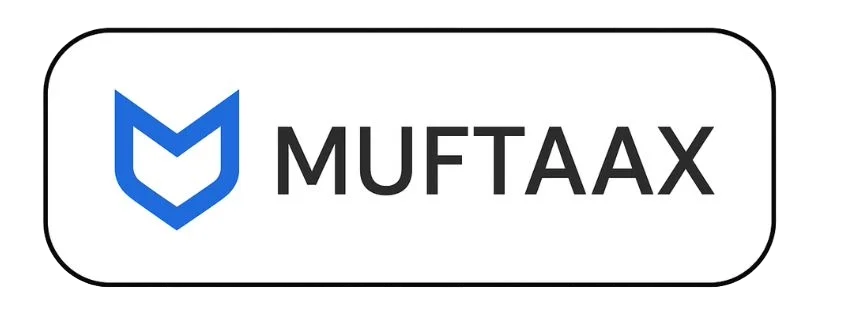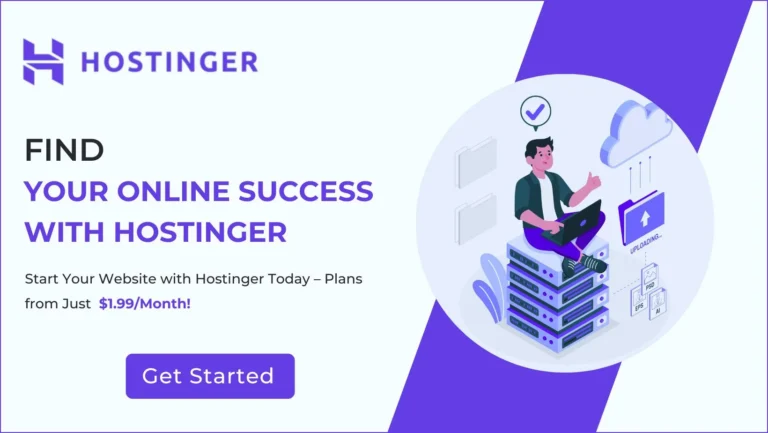Notion Review 2025: Features, Pricing, and Why Everyone’s Using It
Table of Contents
With good reason, Notion has swiftly emerged as one of the most widely used productivity tools for both individuals and teams. It combines databases, note-taking, task management, and collaboration into a single, streamlined, adaptable platform. In this blog post, we’ll examine Notion’s main features, cost, benefits, and drawbacks in order to help you determine whether it’s the best tool for your workflow.
What Is Notion and How Does It Work?
Note-taking, task management, database creation, and collaboration are all combined into one versatile workspace by the productivity app. Notion adjusts to your workflow, whether you’re a team managing assignments, a freelancer managing projects, or a student organizing class notes.
Fundamentally, Notion functions by enabling you to construct “blocks“—the fundamental building blocks of content, such as text, images, tables, embeds, and to-do lists. These blocks can then be grouped into pages, which can then be linked, nested, or created into entire dashboards. Notion’s modular design makes it simple to adapt it to nearly any requirement, from intricate project tracking to personal journaling.
How it Works
- Pages & Blocks: Everything you create in Notion is built from blocks — think of them like digital LEGO pieces. You can mix and match text, headings, checklists, images, videos, code snippets, or databases inside any page.
- Drag-and-Drop Interface: Users can rearrange content freely, creating simple lists or complex workflows without touching code.
- Templates: it offers hundreds of free templates for productivity, CRM, goal tracking, and more — great for beginners.
- Sync & Access Anywhere: it works across desktop, web, and mobile. All your content syncs in real-time.
- Collaboration Tools: You can invite team members to pages, assign tasks, leave comments, and control permissions.
it stands out because it combines the best features of tools like Evernote, Trello, Google Docs, and Airtable into one platform — making it extremely powerful yet lightweight.
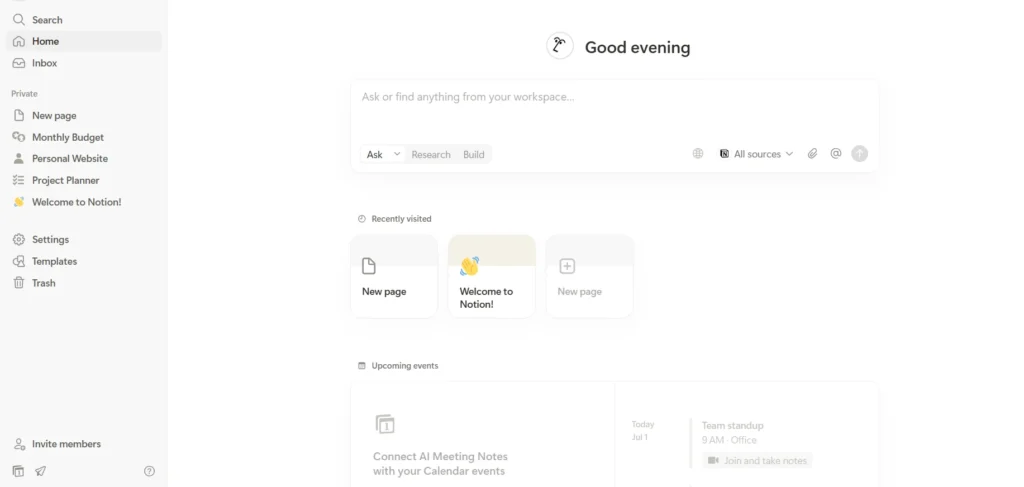
User Interface & Ease of Use
it’s simple and uncluttered user interface is one of the main reasons why people adore it. Everything is highly customizable without being distracting. Notion’s design makes it simple to get started, regardless of your level of experience, and it’s even simpler to grow your workflow over time.
Simple and Intuitive Layout
Notion features a sidebar on the left that shows your pages and subpages, allowing quick access to everything in your workspace. The main workspace on the right is completely blank until you start building with blocks — whether that’s text, checklists, databases, or embedded media.
- Drag-and-drop: Reordering content is as simple as dragging blocks where you want them.
- /Command Menu: Typing “/” brings up a powerful menu of options — from inserting to-do lists and tables to embedding calendars, videos, and code.
- Dark Mode & Custom Fonts: You can toggle dark mode for night use and adjust font styles for better readability.
Learning Curve
it’s easy to get started with, but the more advanced features (like relational databases and formulas) do come with a slight learning curve. Fortunately, it’s offers:
- Beginner-friendly templates
- Onboarding checklists
- In-app tooltips and tutorials
For most users, it takes just a few minutes to create basic notes or task lists, and a few hours to build complete dashboards.
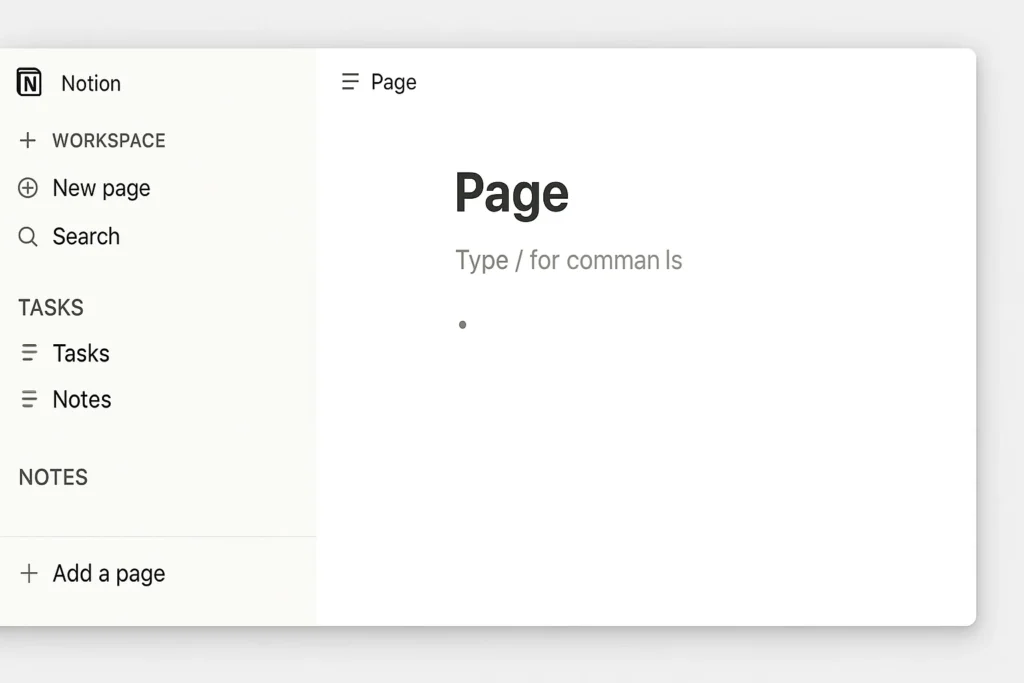
Key Features
it’s unique because of its robust feature set, which combines creativity, structure, and flexibility into a single app. this platform provides you with the tools to do it your way, whether your goal is to create a company wiki, manage a content calendar, or construct a personal planner.
1. Notes & Documents
At its core, Notion lets you take rich-text notes. You can write plain text, add headers, highlight text, and even embed videos, audio, or code snippets. It’s like Google Docs but more flexible.
2. To-Do Lists & Task Management
You can create simple checklists or detailed tasks with due dates, tags, priorities, and reminders. Add them to calendars or Kanban boards for better project visibility.
3. Databases
One of Notion’s most powerful features is its relational databases. You can create:
- Table views
- Kanban boards
- Calendars
- Galleries
All with filters, tags, and sorting options. Ideal for content planning, CRMs, habit trackers, and more.
4. Templates
offers hundreds of free and community-created templates, ranging from student planners to business dashboards. You can also save your own pages as reusable templates.
5. Embeds & Widgets
You can embed Google Docs, Figma files, Loom videos, and dozens of other tools directly into your Notion pages.
6. Real-Time Collaboration
Invite others to collaborate on any page, assign tasks, comment inline, and control who can view or edit content.
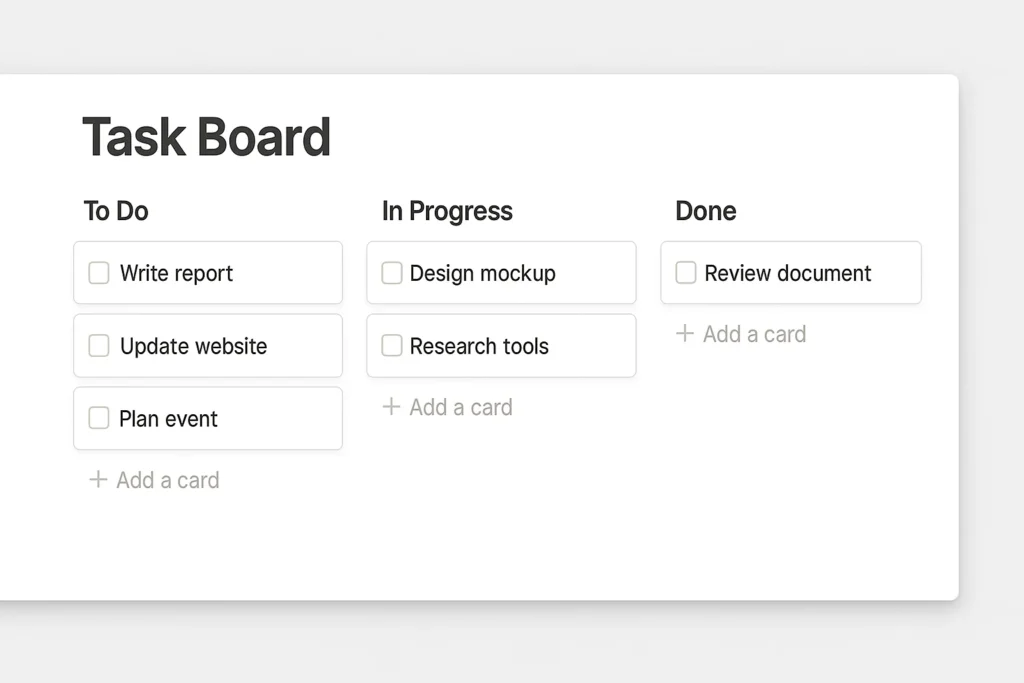
Collaboration & Teamwork
Notion isn’t just for solo use — it’s built with collaboration in mind. Whether you’re part of a small team, a growing startup, or a remote company, makes it easy to work together in real time.
Real-Time Editing and Comments
Multiple users can edit the same page at the same time, with changes syncing instantly across all devices. You can:
- See who’s currently editing.
- Leave inline comments on text or blocks.
- Mention teammates using “@” to notify them instantly.
This makes brainstorming, reviewing documents, and assigning tasks more efficient — especially for remote teams.
Task Assignment and Permissions
it’s allows you to assign tasks to specific team members directly within pages or databases. Each user can see:
- Their assigned tasks
- Due dates
- Comments or updates
You can also set granular permissions:
- View-only
- Comment-only
- Edit access
- Full admin control
This is especially useful when managing clients, contractors, or cross-functional teams.
Shared Team Workspaces
You can organize pages and projects into shared team workspaces, where everyone can access common docs, project plans, and calendars. This makes onboarding, collaboration, and knowledge-sharing seamless.
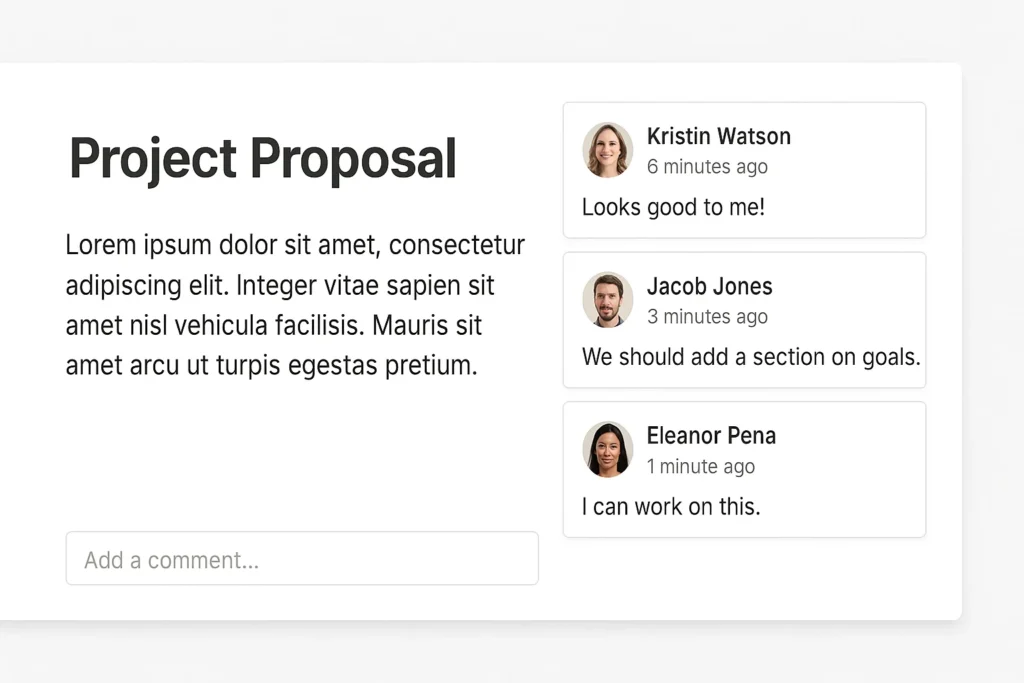
Notion for Project & Task Management
it’s a complete project and task management tool, not just a note-taking app. this platform provides versatile views and features to keep everything organized, whether you’re managing a complicated team project or keeping track of your own to-do list.
Customizable Task Tracking
You can create tasks using simple checklists or embed them into advanced databases with fields like:
- Status (To Do, In Progress, Done)
- Priority levels
- Due dates
- Assigned team members
- Tags or categories
Each task can also contain sub-tasks, attachments, comments, and rich text descriptions.
Multiple Views for Projects
One of Notion’s strengths is its ability to let you view the same data in different ways. With a single database, you can switch between:
- ✅ List view – Clean and minimal
- 📆 Calendar view – Great for deadlines and scheduling
- 🗂️ Kanban board – Ideal for agile workflows
- 🖼️ Gallery view – Visual overview for creative projects
These views can be filtered or sorted to fit your workflow.
Timeline (Gantt Chart Style)
For teams needing timeline management, Notion includes a Timeline view (similar to a Gantt chart). This helps visualize project progress over time and plan dependencies.
Task Templates and Reuse
You can create reusable task templates — for recurring processes like onboarding new hires, launching products, or writing blog posts.
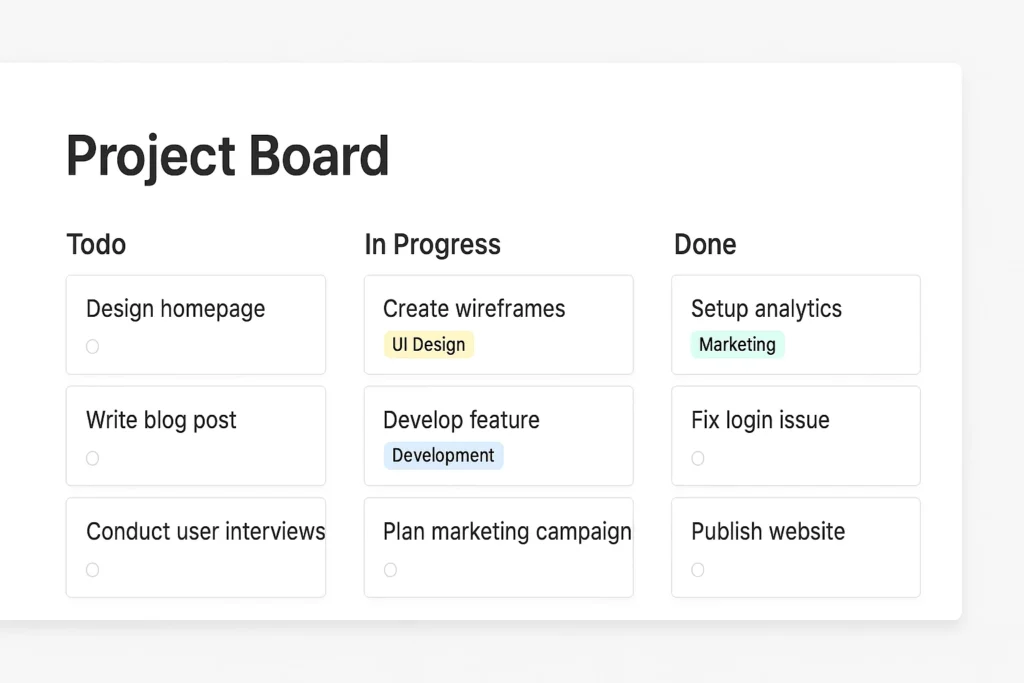
Notion Integrations & Automation
Even though Notion has a lot of power by itself, its true power lies in combining it with your preferred tools. it can boost your productivity with its increasing number of integrations and automation support.
Built-In Integrations
Notion natively supports embedding and syncing with tools like:
- Google Drive (Docs, Sheets, Slides)
- Figma and Loom (designs and video walkthroughs)
- Slack (for notifications and communication)
- GitHub, Typeform, Miro, and more
You can paste a link from any of these platforms into Notion, and it will automatically create a rich preview or embed.
Notion API and Third-Party Tools
For more advanced users, Notion provides a public API. This opens up possibilities for integrating Notion with thousands of apps using platforms like:
- Zapier
- Make (formerly Integromat)
- Automate.io
- Pabbly
With these tools, you can create automated workflows such as:
- Syncing Notion tasks with Google Calendar
- Creating new Notion pages when a form is submitted
- Sending Slack messages when a task is updated
Widgets and Custom Embeds
You can also add interactive widgets like weather, countdowns, habit trackers, or even Spotify playlists using third-party embed tools like Indify or Apption.
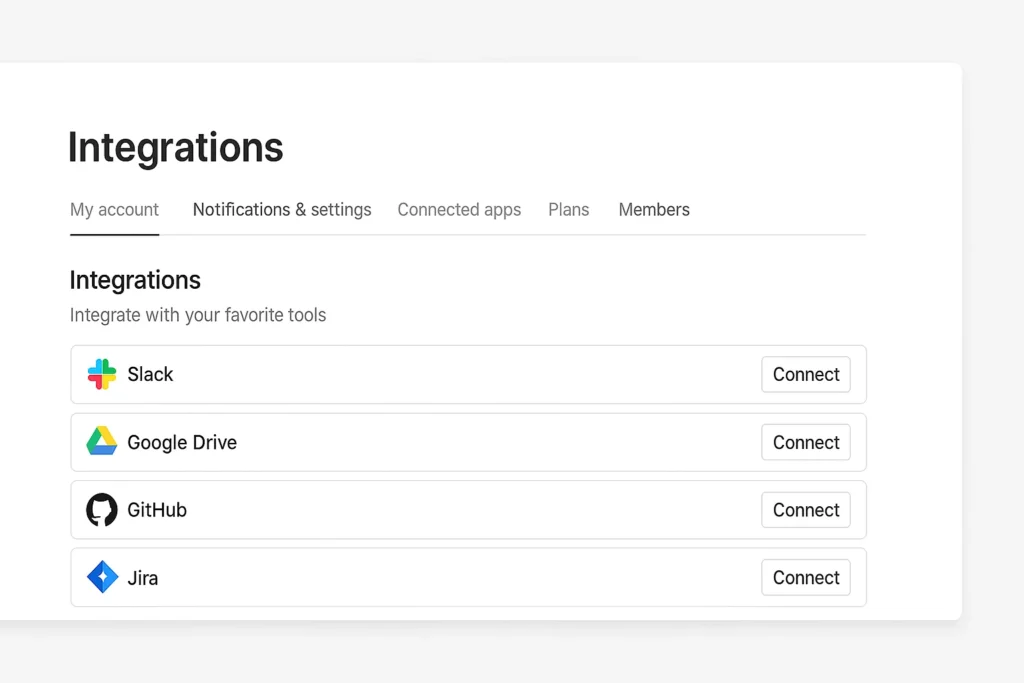
Pricing Plans & Value for Money
One of the reasons Notion has gained massive popularity is its affordable and flexible pricing. Whether you’re using it alone or managing a large team, there’s a plan that fits your needs — and your budget.
1. Free Plan (Best for Personal Use)
- Unlimited pages and blocks
- Share with up to 10 guests
- Sync across devices
- Basic integrations and templates
✅ Perfect for students, individuals, or personal productivity.
2. Plus Plan – $10/month (or $8 billed annually)
- Unlimited file uploads
- Unlimited guests
- 30-day page history
- More advanced page analytics
✅ Ideal for freelancers, small teams, or power users.
3. Business Plan – $18/month (or $15 billed annually)
- SAML SSO
- Advanced permissions
- Bulk PDF exports
- Private teamspaces
✅ Best for growing teams needing more control and security.
4. Enterprise Plan – Custom Pricing
- Advanced security (Audit logs, SCIM provisioning)
- Dedicated success manager
- Custom contract & invoicing
✅ Built for large companies and regulated industries.
Value for Money
Even on the Free plan, Notion offers more than most competitors. Its all-in-one functionality reduces the need for multiple tools (like Trello, Evernote, Docs, or Airtable), making it a cost-effective solution for many users.
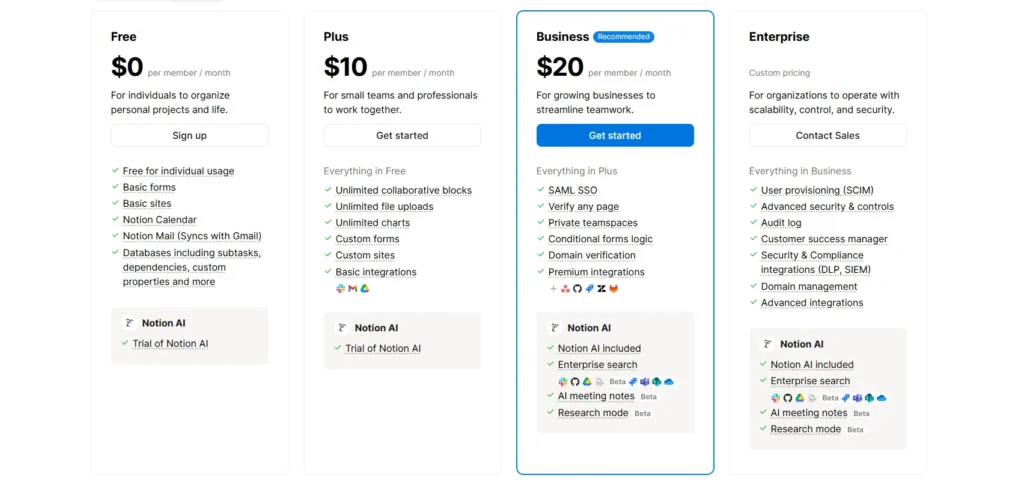
Pros and Cons
Like any tool, Notion has its strengths and weaknesses. Understanding both can help you decide if it’s the right productivity platform for your personal or team needs.
✅ Pros
- All-in-One Workspace
You don’t need separate tools for notes, tasks, wikis, and databases — Notion handles it all. - Highly Customizable
From personal dashboards to full company intranets, Notion adapts to how you work. - Clean User Interface
Minimalist design makes it easy to focus and organize without distractions. - Powerful Templates
Get started fast with hundreds of free and pre-built templates for nearly every use case. - Cross-Platform Sync
Access your content seamlessly across desktop, mobile, and browser. - Strong Free Plan
Many users never need to upgrade, especially solo users or students.
❌ Cons
- Offline Functionality Is Limited
While Notion works offline to an extent, it’s not as robust as other native apps. - Can Feel Overwhelming at First
The flexibility is powerful, but new users may feel lost without templates or guidance. - Performance Drops in Large Workspaces
For teams with massive databases or many nested pages, load time may slow down. - No End-to-End Encryption
Notion stores your content securely, but it’s not the best option for highly sensitive data.
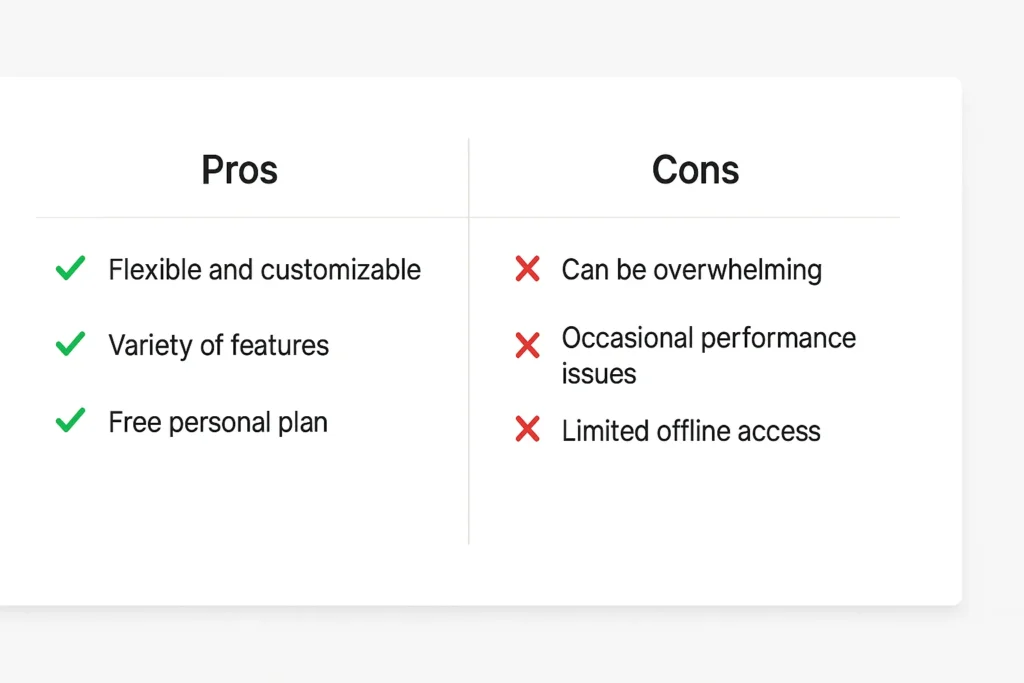
Conclusion
Notion is a strong option if you’re searching for a versatile, all-in-one productivity platform. It offers robust features in a clear, user-friendly design, ranging from note-taking and task management to creating whole databases and collaborative workspaces.
Notion adjusts to your way of thinking and working, whether you’re a team developing internal systems, a student organizing your week, or a content creator managing ideas. Additionally, there is no cost to try it out thanks to a free plan that covers the majority of needs.
Frequently Asked Questions
1. What is Notion?
Notion is a versatile productivity app that combines note-taking, task management, databases, and collaboration into one powerful platform. It’s used by individuals, students, and teams to stay organized and manage projects efficiently.
2. What is the main use of Notion?
The main use of Notion is to organize and manage information. People use it to take notes, create to-do lists, manage content calendars, plan projects, and build databases — all in one workspace.
3. How to explain a Notion?
Notion can be explained as an all-in-one digital workspace. Think of it as a tool where you can write, plan, organize, and collaborate — using blocks (text, tasks, media, tables) to build custom workflows tailored to your needs.
4. Is Notion really free?
Yes, Notion offers a generous Free plan that includes unlimited pages and blocks, real-time sync, and sharing with up to 10 guests. For personal use or small projects, the free version is more than enough.
5. Why is Notion famous?
Notion is famous for its flexibility, minimal design, and all-in-one capabilities. Unlike most tools that focus on one thing, Notion lets users do everything — from writing notes to building complex project dashboards — all without switching apps.
Get Notion free!!
👉 Sign up here and start building your own digital workspace today.

